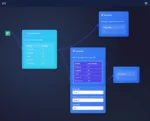
by tyler garrett | May 12, 2025 | Solutions
Decision-makers are continually tasked with deriving deeper insights from increasingly complex data streams.
While traditional analytics often focus purely on standard numeric datasets, modern competitive organizations understand the strategic value of integrating multi-modal sensory analytics – leveraging audio, visual, and text data formats together for richer insights and in-depth decision-making.
This emerging frontier delivers more precise outcomes, enabling organizations to respond faster, innovate confidently, and remain agile amidst relentless market shifts.
To help leaders navigate this evolving landscape, we’ll provide clarity on the value and strategic implementation of multi-modal analytics and illustrate why cross-domain unified analytics represents the future of business intelligence.
Understanding Multi-Modal Analytics: The What and the Why?
The term “multi-modal analytics” may sound complex, but its premise is surprisingly intuitive. This practice entails blending diverse data modalities—specifically audio, visual, and textual streams—into comprehensive, unified analyses to create richer insights and more informed decisions. For example, combining speech audio analysis from customer service calls along with customer review texts and video feedback can offer deeper emotional context, sentiment analysis, and nuanced insights unattainable by traditional analytics relying solely on structured numerical data.
Why diversify data inputs? Simple—human experiences and interactions reflect themselves through multiple sensory channels simultaneously. Leveraging this phenomenon drives significantly richer customer understanding, product improvement opportunities, brand sentiment analysis, and market trend forecasts. Implementing advanced multi-modal analytics enables firms to move beyond limited isolated analyses and develop holistic capabilities. From customer experience analytics in retail to portfolio optimization in financial sectors, the inclusion of audio and visual cues alongside text analysis—combined seamlessly via modern software capabilities and innovative data methodologies—results in sharper business intelligence, strategic clarity, and greater competitive edge.
Core Benefits of Integrating Sensory Data Streams
1. Richer Contextual Insights
Human communication relies heavily on signals beyond mere vocabulary text—music, voice tone, facial expressions, and gestures illuminate richer meanings beneath surface-level interactions. Combining audio and visual analytics, such as vocal sentiment detection or video emotion recognition, alongside traditional text analysis creates complete insight portraits. For instance, integrating customer call audio analysis with textual transcripts offers powerful clues into customer frustration or satisfaction that purely textual transcripts may overlook, improving customer service optimization outcomes.
2. Faster, More Accurate Decision-Making
Speed and accuracy directly influence competitive advantage. Certain market scenarios, such as financial trading or crisis event detection, demand rapid analytical judgment calls. Leveraging integrated visual, audio, and textual analyses rapidly pinpoints emerging trends, opportunities, or risk signals. Aligning disparate data sources harmonizes analyses quicker. To facilitate this, advanced firms embrace modern data engineering capabilities, much like we outline in our blog discussing the importance of CI/CD pipelines, to streamline modifications and deployments of multi-modal analytic solutions that deliver quicker insights and greatly enhance performance.
3. Better Customer and Market Understanding
Enterprises consistently strive toward deep customer and market insights. Conventional numeric measures alone often fall short, but multi-modal analytics generate effective strategic understandings. By analyzing visual, textual, and audio-based customer reactions together, businesses gain granular behavioral insights. Consider e-commerce—combining product review sentiments (text analytics) with customer support calls (audio tone detection) and unboxing video sentiment (visual analysis) significantly strengthens customer-centric strategies. This level of insight enhances product improvements, optimizes engagement, and identifies subtle customer experience upsides often missed in traditional isolated data approaches.
Technical Considerations: Challenges & Strategic Approaches
Even as comprehensive multi-modal analytics promise strategic transformation, challenges persist around data ingestion, compatibility, storage capabilities, reliability, and potential schema conflicts. Different formats and schemas across audio, visual, and textual datasets require sophisticated techniques such as polymorphic schema handling in data lakes, ensuring your ingestion architecture flexibly accommodates diverse sources and supports future growth without sacrificing robustness.
Enterprises must also embrace semantic analytics in cross-discipline analyses, moving beyond basic keyword approaches to capture nuanced meanings. Innovation in semantic technology—such as those detailed in our guide on semantic embeddings for business intelligence—promises powerful approaches for accurately interpreting human-generated unstructured data streams across audio, visual, and written formats, driving better analyses and deeper business intelligence.
Strategically, adopting effective pipeline designs becomes critical to efficiently move, transform, and analyze multi-modal data. Choosing between traditional approaches like ETL (Extract, Transform, Load) or more flexible modern methodologies like ELT (Extract, Load, Transform) depends upon your data strategy and internal infrastructure, a topic explored comprehensively in our article comparing ETL vs. ELT approaches. Organizations prioritize technical partnerships and consulting services in data to confidently navigate this complexity and deliver high-performance outcomes rapidly.
Implementing Multi-Modal Analytics: Practical Steps for Your Organization
Evaluate Organizational Readiness
Begin your journey toward fully integrated sensory analytics by accurately assessing readiness regarding data capabilities, infrastructure, technical talent, and budget availability. For organizations facing financial constraints, consider practical cost-saving methods documented in our article on setting up modern data stacks economically. This evaluation phase determines gaps and identifies your specific investment roadmap, shaping your strategic analytics direction clearly.
Define Clearly Aligned Objectives
Organizations often overlook well-defined, aligned multi-modal analytics objectives, wasting resources on inefficient exploratory experimentation. Instead, align sensory analytics objectives clearly with specific business goals—customer sentiment, product experience, or risk management, among others. Leveraging frameworks addressed in our detailed breakdown of domain-driven data design enables organizations to isolate and prioritize relevant requirements clearly, resulting in effective outcomes and strong strategic impact.
Ensure Data Quality & Governance
Data integrity and governance in analytics become critically important in multi-modal use cases, largely due to complexity and source variety. Deploying proven data quality testing frameworks—such as those discussed in our comprehensive comparison of data testing methodologies—ensures accurate, robust analytical insights. Consistent quality assurance across audio, visual, and text sources minimizes risks, improves decision accuracy, and fosters stakeholder confidence in the long-term integrity of sensory analytics.
Avoiding Pitfalls and Common Mistakes in Multi-Modal Analytics Implementations
Despite significant advancements, new adopters discover common pitfalls. Typical errors, such as siloed modality-specific approaches or reliance on inadequate or overly complex tools, often undermine the effectiveness of combined sensory approaches. One should cautiously approach the solution landscape and pay attention to established industry advice—such as our insights into the most overrated tools in data engineering—to avoid expensive missteps and wasteful distractions.
Startups and established enterprises alike regularly face specific data implementation challenges. Our research on the top data mistakes prominent among startups provides key lessons relevant across all enterprise maturation stages, ensuring organizations adopt multi-modal analytics strategically, responsibly, and effectively.
Furthermore, ensuring analytical outputs drive impactful insights requires the practical understanding of different visualization types. For sensory data integration, continually reference our expert guide examining data visualization types, ensuring visual simplification and clear presentation amplify analytical advantages effortlessly for stakeholders.
The Evolving Frontier of Sensory Analytics
Multi-modal analytics represent the convergence of technical innovation, strategic opportunity, and integrated data intelligence. Organizations mastering sensory analytics will secure a substantial competitive edge by revealing hidden customer insights and gaining better market understanding. Strategic adoption ensures agile analytics, flexible innovation, informed strategic decision-making, and practical business advantage.
As decision-makers, embracing integrated multi-modal sensory data unlocks richer insights—propelling organizations toward future success. The sensory analytics renaissance is here—lead proactively.

by tyler garrett | May 11, 2025 | Solutions
Strategically structuring your data teams isn’t just about having the right people in the room; it’s a meticulous exercise in orchestrating collaboration, defining clear roles, and laying down solid frameworks. In today’s data-intensive marketplace, businesses that master the science of structured teamwork unlock unprecedented innovation potential and achieve impactful breakthroughs faster. Whether you’re refining data visualization practices, enhancing performance through advanced database strategies, or fortifying stability and security, carefully planned data team structures serve as the architectural backbone of success. Let’s explore how leaders can design their own effective, dynamic, and future-proof data team structures.
Why Data Team Structure Matters for Organizational Growth
In an era dominated by the widespread use of analytics and business intelligence, the effectiveness of a data team directly correlates to organizational agility, growth, and competitive advantage. Companies flourishing in today’s fast-paced market understand that data teams aren’t merely groups of analysts and engineers—they are strategic business units uniquely placed to unlock a deeper understanding of the market, customers, and internal processes.
An effective data team structure defines clear roles, responsibilities, and workflows, creating transparency and minimizing friction. Structures that align data experts closely to decision-makers allow for rapid iteration, feedback, and data-driven decision-making. Conversely, poor structures result in siloed workflow, bottlenecks, inefficient use of resources, and ultimately slower innovation cycles.
Today, organizations rely heavily upon modern database solutions, making robust data handling technologies such as those described on our MySQL Consulting Services page increasingly critical. Thoughtful team organization ensures everyone knows their responsibilities clearly, enabling disciplined database management, advanced querying, and accurate analytics delivery to propel strategic growth effectively.
Essential Roles in a Successful Data Team
Successful data teams consist of several specialized complementary roles that collaboratively address diverse organizational requirements. The fundamental roles essential for nearly every data-oriented team structure include Data Engineers, Data Analysts, Data Scientists, Visualization Specialists, and Data Leaders (such as Chief Data Officers or Data Managers).
Data Engineers
Data Engineers form the foundation, responsible for data infrastructure design, data pipelines, database administration, and ensuring accurate data collection and processing. They ensure data accessibility and reliability, employing techniques described in our guidelines on how to collect and clean your data effectively.
Data Analysts
Data Analysts utilize their deep understanding of business data to answer questions and provide insights to drive operational efficiency and business growth. From mastering data manipulation through SQL operators—like pattern matching techniques explained in our guide Mastering Pattern Matching with the LIKE Operator in SQL—these analysts interpret results and uncover trends that significantly impact overall decision-making.
Data Scientists
Data Scientists push boundaries with advanced modeling and machine learning practices to predict outcomes, uncover hidden relationships, and foster innovative business solutions. Their deep statistical and mathematical foundation helps convert raw data into actionable strategic intelligence.
Visualization Specialists
Visualization specialists, proficient at selecting the right visual charts and dashboards as described in our article Choosing Appropriate Chart Types for Your Data, translate technical insights into user-friendly graphical representations, breaking down complex data into actionable visuals easily digestible by stakeholders.
Data Leaders
Finally, the Data Leader orchestrates these specialized areas, aligning the overall data strategy with business goals. They empower teams, foster collaboration, and actively advocate strategic use of analytics across all departments.
Models for Structuring Your Data Team
There isn’t one single ‘best’ design for data teams—each organization chooses the structure aligning closest with its strategies, culture, business size, and objectives. Below are three prevalent structures organizations commonly adopt today:
Centralized Structure
This model features a single unified data team responsible for all data-related projects across the company. Typically governed by a Chief Data Officer (CDO), it can efficiently manage resources, define uniform technical practices, and maintain company-wide standardization in tools, processes, and security strategies—crucial given the increasing demands on enhanced data security in today’s quantum era.
Decentralized (Embedded) Structure
In contrast, decentralized setups embed dedicated data teams within individual business units. This decentralization brings data experts closer to business stakeholders, offering faster reaction times, better alignment with departmental priorities, and optimized analytical specificity—critical for organizations that benefit from agility, such as startups or rapidly scaling companies.
Hybrid Model Structure
This approach combines elements from both centralized and decentralized structures, blending standardized data governance with agile, responsive team units embedded in different business departments—offering balanced advantages. A hybrid model often serves large enterprises or firms undergoing rapid digital transformation, where speed and steady governance simultaneously matter.
Leveraging Technology to Boost Data Team Productivity
An effective data team combines the right professionals with the right tools. Investing in robust platforms and tools contributes incredibly to improved productivity and streamlined team performance. Solutions such as MySQL with specialized consultancy, as detailed in our MySQL Consulting Services, facilitate powerful data operations. Adopting advanced data analytics tools ensures your team achieves superior results, gaining significant advantages over competitors who rely on legacy systems.
Additionally, teams should leverage robust visualization tools such as PowerBI or Figma for dashboard creation that simplify data communication. Our guide on tracing dashboards using Figma and PowerBI offers powerful workflow techniques, enabling teams to streamline their visual reporting.
Providing your team secure technology infrastructure also plays a crucial role. Thorough and proactive security practices as elaborated in our comprehensive article on Enhanced Data Security profoundly impact team reliability and protect valuable information resources in today’s fast-changing technological landscape.
Cultivating a Collaborative Culture and Continuous Learning Environment
Beyond personnel and technology, the most successful data teams embrace a vibrant culture characterized by openness, collaboration, innovation, and continuous learning. Organizations that champion diversity in data resources and perspectives, as explained in Unleashing the Power of Data Diversity, benefit significantly from unique insights that help drive innovations and distinguish them from competitors.
Leaders should cultivate a positive atmosphere that encourages curiosity, experimentation, and professional development. Regular training sessions, workshops, teamwork activities, and knowledge sharing significantly enhance team skills in methods such as modifying databases—like detailed in our article Update: Modifying Existing Data in a Table—leading directly to productivity boosts and increased data maturity across teams.
Lastly, an environment where professionals freely share insights without hesitation drives stronger creative collaboration and functionality. Encouraging transparency eliminates silos, fosters due diligence, and creates an empowered environment where the team’s combined intelligence drives optimized organizational decisions.
Final Thoughts: Your Data Team Structure Shapes Your Company’s Future
The strategic design of your data team structures profoundly aligns with your company’s core priorities, strengths, and long-term goals. Organizations capable of regularly optimizing these structures reap direct strategic benefits, including improved analytics, deeper insights, and greater innovation levels.
Starting this journey effectively requires understanding your organization’s unique objectives and culture, clearly defining roles, selecting appropriate technologies, and fostering a positive, agile culture dedicated to continuous improvement. Remember: The right data team isn’t static but an evolving ecosystem, fluid enough to embrace change and robust enough to catalyze transformative growth. Navigate your data maturity journey strategically, and your optimized data team structure will transform into a powerful engine of innovation, decision-making, and sustained organizational success.

by tyler garrett | May 10, 2025 | Solutions
In today’s data-driven landscape, your company’s infrastructure isn’t just a backend utility—it’s the foundational backbone that determines your organization’s growth trajectory and sustainability. As your business expands, so does the volume, velocity, and variety of data you need to manage, analyze, and leverage strategically. Plenty of ambitious businesses hit the steep wall of data infrastructure limitations precisely when momentum is crucial. But with thoughtful foresight and strategic planning, scaling your data infrastructure shouldn’t mean stressful late-night firefighting—rather it can drive significant competitive advantages. In this guide, we’ll navigate the strategic roadmap to effectively scale your data infrastructure along your growth journey, setting you up for enduring success.
Understand Your Current Data Ecosystem Before Scaling
Scaling data infrastructure without a keen understanding of your existing data ecosystem can lead to costly inefficiencies or even operational breakdowns. To navigate your growth effectively, it’s crucial to map out your current databases, data flows, analytics tools, and data security protocols. You should clearly identify bottlenecks and single points of failure, pinpoint aspects like downtime susceptibility or overloaded servers, and understand your current hardware limits and software performance. Understanding your ecosystem will guide informed, scalable technology decisions rather than the common mistake of merely throwing resources at performance problems.
Conduct a thorough analysis of your organization’s infrastructure to understand which components need immediate attention or upgrading. For instance, if you’re facing database management issues, you’ll want to ensure basic maintenance skills are up to par with guides such as our detailed article on resetting MySQL root password on Mac OS. Knowing exactly what’s “under the hood” will empower your team to proactively improve performance, enhance security, and streamline processes before moving further into more complex infrastructure innovations.
Mapping out your existing data infrastructure gives your leadership and technical team a clearer visibility into areas requiring immediate attention. This insightful assessment sets a strategic roadmap for scaling your infrastructure effectively, ensuring both short-term efficiency gains and long-term scalability.
Implement Effective Data Models to Enable Scalable Growth
A strategically designed data model is critical for efficiency and scalability. As businesses scale, poor choices in data model planning commonly result in cumbersome data retrieval speeds, complex databases, and analytical inaccuracies that undermine decision-making. A robust data modeling strategy enables quicker analytics, simplified maintenance, and enhanced reliability, giving your business the clarity it needs at every growth stage. Investing early in designing effective data models ensures your system can scale efficiently as you accumulate more complex and diverse data sets.
If you’re relatively early in the process of scaling your data infrastructure, our insightful resource, A Beginner’s Guide to Data Modeling for Analytics, will provide you with foundational knowledge to ensure your data model supports growth rather than hindering it. Early choices, such as normalization versus denormalization and entity relationships, can make profound differences in future scalability. Consider also your expected query patterns, reporting demands, and user analytics needs to optimize your data models to support rapid business decisions and innovations.
Strategically designed data models lay the groundwork for long-term success. Organizations leveraging thoughtfully crafted models find themselves with fewer database growing pains and far more flexibility when responding to evolving business objectives, allowing seamless infrastructure scalability as your business flourishes.
Leverage Cloud-Based Data Infrastructure Solutions
As your business increasingly depends on extensive data to run its operations, traditional on-premises solutions may begin to demonstrate clear limits. Cloud-based data infrastructure solutions are specifically engineered for scalability, eliminating many of the challenges associated with on-premises systems. Cloud services offer easy resource expansion, redundancy, disaster recovery, and security measures that are crucial for handling escalating data volumes and complexity.
Cloud infrastructure solutions allow agile, resource-efficient scaling, freeing your IT team to focus on innovation instead of dealing with hardware and networking constraints. They offer valuable predictive analytics capabilities, supporting precise and proactive decisions. Cloud data warehousing solutions can integrate effortlessly with data visualization tools, enabling highly scalable visual analytics. Services like our customized data visualization consulting help to supercharge your cloud analytics capabilities, giving your enterprise an actionable edge.
Additionally, cloud solutions enable rapid prototyping and quick integration with cutting-edge analytics solutions, including AI or machine learning. In fact, our article about trusting AI to vet software engineers highlights the advanced possibilities of integrated scalable cloud operations meeting current market demands. Through leveraging cloud infrastructures, scaling your data operation becomes proactive, strategic, and pointed towards continued innovation, empowering your business to reach new efficiency levels with lower costs.
Optimize and Automate Your ETL Processes
An effective Extract, Transform, Load (ETL) system is core to scalable data infrastructure. As data size and variety expand, optimization and automation of your ETL processes become essential to avoid slowdowns, bottlenecks, and inaccuracies in data delivery. Manual ETL processes may have functioned adequately with small data sets but as data volume scales, these processes frequently fail to deliver necessary accuracy, speed, and reliability.
Modern businesses employ automated ETL solutions to seamlessly manage data processes. While previously ETL might have seemed complicated or difficult to deploy, the benefits are undeniable. You can gain in-depth insights by reviewing our carefully documented case studies of successful ETL implementations spanning industries, proving ETL automation improves productivity, accuracy, and the quality of analytical results. Scalability depends heavily on automation, allowing your team to shift their resources to value-added analytics tasks rather than maintenance and repetitive tasks.
Leveraging data integration automation and intelligent ETL processes ensures vital information reaches decision-makers quickly and accurately, thus enhancing decision effectiveness and strategic capabilities. Scalable data infrastructure requires proper integration with smart ETL automation to significantly contribute toward overall data efficiency, reliability, and optimal infrastructure performance.
Prioritize Data Security and Risk Management as You Scale
Risk management and data security are absolute necessities as your company’s data infrastructure scales. Expanding your data estate introduces new cybersecurity risks and compliance challenges, significantly raising the stakes for data breaches and associated reputational damage. While addressing vulnerabilities early in your scaling journey seems like an added burden, the true cost of neglecting security is immeasurably greater.
As databases and analytics tools increasingly expand across multiple cloud infrastructures, data movement between multiple endpoints heightens security vulnerabilities. Implementing robust data governance frameworks, encryption, access controls, and automated threat detection are essential constituents of a scalable and secure infrastructure. Learn from industries particularly sensitive to data security challenges, such as finance—explained in our article discussing the finance industry’s critical dependence on data and the associated risks. Building data security strongly into infrastructure scalability requirements will shield your company from costly cyber risks.
A proactive commitment to risk assessment and security protection ultimately scales infrastructure safely, enabling your organization to expand and innovate without risking the integrity of sensitive information. This responsible approach delivers sustainability, legal compliance, and customer confidence.
Establish Proactive Monitoring and Incident Response Systems
Reliable, scalable infrastructure goes beyond data storage and analytics. Establishing proactive monitoring tools and a clear incident response framework is crucial. Implement systems that constantly track your infrastructure performance and alert you immediately to key problems, preventing minor incidents from escalating into catastrophic downtime or data loss.
Infrastructure monitoring tools, real-time analytics dashboards, and automated accountability mechanisms move your company towards a self-healing infrastructure, resolving problems efficiently before users even notice. Lay foundations by establishing efficient workflows like our recommended approach described in our article on creating efficient systems to address high-priority issues effectively.
A robust and responsive infrastructure monitoring system fundamentally supports rapidly scalable data infrastructure. Effective monitoring systems also enhance transparency within your operations and empower data teams to build strategic, confident decision-making practices. This adds tangible business value by maintaining high infrastructure availability rates and reliably fast response times required for analytics and innovation.

by tyler garrett | May 10, 2025 | Solutions
In today’s data-driven ecosystem, timely and continuous data processing has become paramount for businesses aiming to achieve real-time analytics and insights. However, with vast and complex streams of information constantly flowing from numerous sources, managing backpressure—the scenario in which downstream systems become overwhelmed by an upstream surge of data—becomes crucially important. Handling backpressure effectively ensures your streaming framework remains performant, resilient, and scalable. As leaders in delivering advanced analytics and innovative solutions, we’ve guided numerous companies through the complexities of managing high-velocity data streams. In this comprehensive guide, we’ll dive into robust backpressure handling strategies designed to empower your business to maximize the value and performance of your data streaming architectures.
Understanding the Basics of Backpressure and Its Impacts on Data Streams
Backpressure occurs in data streaming when downstream nodes or applications cannot keep pace with the rate of incoming data from upstream processes, leading to potential performance bottlenecks, operational delays, or even system failures. To understand why handling backpressure is essential, let’s first clarify why it happens. In modern, distributed data architectures—such as Apache Spark Streaming, Kafka, or Flink—streaming workloads consist of producers (upstream) generating data and consumers (downstream) processing, storing, or analyzing it. When throughput mismatches occur, either due to sudden spikes in incoming data volume, resource limitations, or processing inefficiencies, the downstream components may fail, slow down, or drop valuable data.
Proper backpressure management helps maintain resilient, fault-tolerant systems, and ensures your architecture can adapt to fluctuating data flow gracefully. Poorly managed backpressure, on the other hand, can significantly impact analytical results, degrade performance, and compromise system stability. Businesses relying heavily on predictive analytics—like those aiming at advanced implementations similar to our experiences in leveraging predictive analytics for enhanced supply chain management—cannot afford interruption or delays in data processing. Thus, a clear understanding of backpressure’s fundamentals and its consequences forms the basis for deploying effective mitigation strategies.
Popular Backpressure Handling Strategies for Data Streaming Architectures
With an ever-increasing adoption of sophisticated big data streaming frameworks, application designers and technology strategists need proven, robust strategies for managing backpressure effectively. Let’s explore some popular and practical techniques that have become widely adopted:
Buffering and Queueing
One fundamental yet powerful strategy is to implement buffering and message queuing systems, such as Apache Kafka, RabbitMQ, or Amazon Kinesis. Buffering offers a temporary data storage layer to keep incoming data when the system’s processing capabilities are temporarily surpassed. By decoupling data producers and consumers through buffering, the system easily handles occasional spikes in inflowing data and mitigates congestion proactively. However, buffering capacity, retention times, and throughput must be carefully planned, as overly aggressive settings can lead to memory issues or data-loss scenarios.
Adaptive Throttling and Flow Control Mechanisms
Adaptive throttling aligns the message ingestion rate of upstream processes with downstream processing capabilities. It dynamically adjusts message flow based on real-time conditions. Technologies like Apache Spark Streaming even include built-in mechanisms for dynamically managing backpressure situations. Organizations can further optimize these techniques by following certain industry best practices for performance optimization, such as those discussed in optimizing Spark jobs, ensuring maximum stream stability.
Distributed Scaling and Load Balancing
A common method to handle backpressure involves horizontal scaling and distributing workloads across multiple nodes or clusters. Scaling out solution components and implementing intelligent load balancing distribute processing workloads evenly, offering significant performance improvements and fault tolerance. Cloud services technologies further simplify distributed scaling, allowing organizations to quickly react to changing performance needs, improve fault tolerance, and facilitate smoother operations.
Implementing Effective Monitoring and Alerting for Early Detection of Backpressure
Early awareness of possible bottlenecks through effective monitoring is essential for proactive backpressure mitigation. Organizations must implement strategic monitoring solutions that offer detailed visibility across data streaming infrastructures. Robust monitoring enables stakeholders to identify strained processing nodes, rate mismatches, and data bottlenecks in near real-time. Customized alerting can further help avoid downtime and operational disruption by notifying technical teams immediately when backpressure situations arise, providing early actionable information.
Innovative monitoring approaches may involve integrating powerful visual analytics through business intelligence tools like Tableau, which can further enhance monitoring effectiveness by automating visualizations such as our methodology shown in Tableau Server automated dashboard images. Ensuring visibility into even subtle performance degradation enables data engineers and decision-makers to proactively correct backpressure before it escalates into critical operational impacts.
Benefits of Implementing Robust Backpressure Controls in Your Streaming Architecture
The upfront efforts of designing, deploying, and operationalizing robust backpressure handling strategies pay considerable dividends. The business and technical advantages include dramatically improved system reliability, reduced data loss, and enhanced performance under varying data load conditions. Leveraging expert backpressure handling principles leads to increased infrastructure efficiency and maximized return from streaming data investments.
For instance, ensuring real-time data consistency is crucial when integrating datasets through real-time API connections—like the robust integrations offered through experienced providers such as our Procore API consulting services. Real-time streaming with effective backpressure control ensures seamless data integration across multiple business units, ultimately empowering more accurate, timely insights, and reducing critical decision-making delays.
Applying Advanced Analytics and Predictive Models to Anticipate Backpressure Scenarios
An effective long-term approach to backpressure mitigation involves predictive analytics capable of forecasting peak demand periods and proactively allocating resources accordingly. This proactive strategy helps reduce or entirely avoid backpressure situations. Businesses that successfully harness predictive analytics not only improve stream operations but unlock lasting strategic improvements across their entire analytical ecosystem—for example, integrating advanced customer churn insights as discussed in our article about predicting client churn with open-source tools.
Utilizing predictive modeling tools, teams can enhance their operational intelligence, optimizing resources before a known demand spike occurs. These predictive analytics capabilities provide another layer of proactive control over your streaming architecture by helping pinpoint situations requiring urgent intervention and aiding faster resolution, minimizing negative effects on critical business processes. Furthermore, combining forecasting methods with advanced analytics empowers organizations to be more financially efficient, optimizing resources, cost allocation, and operational decisions well in advance.
Strategically Aligning Backpressure Solutions with your Business Objectives and Data Priorities
Ultimately, integrating effective backpressure management into your streaming architecture requires deep alignment between technological infrastructure and the overarching business priorities. Stakeholders must transparently communicate core data priorities, define upstream and downstream rate capabilities, and monitor strategic outcomes closely. Decision-makers should also analyze customer lifetime value patterns—leveraging learnings we’ve extensively discussed in articles such as Investing in the right customers using CLV analysis—as a means of prioritizing and optimizing resource allocation and system stability.
Additionally, business teams should always ensure smooth user experiences, stable analytics adoption, and reliable data delivery—strategic goals supported by effective backpressure management. Backpressure control, therefore, becomes not just a technical goal but a critical strategic business capability, enabling organizations to innovate faster, understand customers better, and gain a data-driven competitive edge.
By embedding strong backpressure handling mechanisms into your streaming architecture and aligning technical implementations with your business strategies, your organization can reap substantial performance, resilience, and innovation rewards.

by tyler garrett | May 10, 2025 | Solutions
Imagine your data warehouse as a sophisticated library—a place where performance, accuracy, and scalability are paramount. Now, picture traditional warehousing methods as librarians endlessly reshuffling books, changing their locations, and often losing valuable context or leaving inconsistencies behind. Content-addressable storage (CAS) emerges as the smarter librarian—storing your books (data) once at an address uniquely determined by their content. CAS fundamentally transforms your warehouse into an immutable, efficient, and reliable powerhouse. As data volumes grow exponentially, adopting a storage system designed for immutability isn’t just a forward-thinking move; it’s becoming a necessity for sustainable modern business analytics.
Understanding Content-Addressable Storage: The Basics
Let’s start by demystifying content-addressable storage. CAS is a method of storing data where each unique piece of data is identified by a cryptographic hash of its contents, rather than hierarchical paths or conventional file system naming. This approach generates a unique identifier for every file or object based on its actual content, making each entry immutable by design. Once stored, a piece of data cannot be altered without changing its resulting address, ensuring data integrity and providing inherent auditability.
For anyone involved in data warehousing or analytics, this immutability is highly advantageous. It simplifies version control, reduces redundant storage, and enhances system-wide transparency. By adopting a CAS framework, businesses eliminate inconsistencies common in mutable storage architectures, significantly enhancing data accuracy and reliability.
This idea of keeping your data uniquely indexed and tamper-proof also complements advanced analytics solutions. For instance, incorporating CAS with powerful visualization platforms—like Tableau—can drastically improve data discovery and decision-making. Check out our comprehensive coverage of the Tableau definition and understand how aligning powerful visualization tools with robust storage systems heightens analytical capabilities and ensures trusted business intelligence.
The Business Case for Adopting CAS in Immutable Data Warehousing
In data-driven enterprises, accuracy, scalability, and security underpin virtually every operational decision. Implementing CAS-based immutable storage solutions significantly strengthens an organization’s data governance initiatives and satisfies regulatory compliance efforts. Because content-addressable storage inherently ensures that once data is written, it remains unchanged, this supports regulatory mandates like GDPR and industry-specific compliance frameworks which emphasize data integrity and traceability.
Consider the process of auditing or historical reporting. Using CAS, when business stakeholders request historical data insights, IT teams can easily and confidently reference data snapshots taken at precise points in historical context. This drastically simplifies troubleshooting and auditing tasks, saving countless hours traditionally spent tracing altered or inaccessible data.
Additionally, CAS storage solutions inherently deduplicate data and simplify replication processes across multiple locations. Enterprises avoid the financial impact traditionally associated with storing redundant data copies. In data-rich environments, this economic efficiency quickly translates into noticeable financial savings, enhancing overall business agility and reducing overhead storage costs.
Integrating CAS to Enhance Data Visualization and Analysis
Data visualization workflows significantly benefit from immutability and transparent data lineage offered by CAS. For analysts and stakeholders leveraging immersive dashboards, generating insights and maintaining trust in visualizations becomes far easier when data origins remain clear and unaltered. When users engage in in-depth exploration, a content-addressable foundation ensures that visualizations accurately reflect reliable source data snapshots without the threat of unexpected mutations or drift.
Want strategies to design dataviz that convey information powerfully? Check out our 10 Tips for Creating Effective Data Visualizations and discover how robust data storage bolsters the reliability underlying your visual messaging. Progressing further, explore how visualization directly propels business success through our insightful analysis: The Power of Data Visualization in Business.
Technical Advantages: Why Immutable Data Warehousing Matters
Content-addressable storage unlocks substantial technical advantages within your data architecture strategy. Immutable data warehousing simplifies the architecture for self-healing and inherently fault-tolerant data pipelines. With robust CAS infrastructures, automated processes easily identify anomalies or corrupted data by recognizing inconsistencies through hash mismatches, making your pipeline “self-aware” and inherently more resilient to transmitting bad data downstream.
By complementing CAS with robust frameworks such as implementing self-healing data pipelines using circuit breaker patterns, businesses significantly enhance data reliability and reduce incident response time. Consequently, automation coupled with immutability leads to greater operational efficiency, allowing data scientists and engineers more freedom to focus on analytics and innovation rather than troubleshooting or firefighting.
Furthermore, CAS pairs exceptionally well with emerging paradigms like computational storage, which embed intelligence directly into the storage devices themselves. Together, computational storage and CAS can significantly reduce the overhead associated with data transfer between compute and storage layers, enhancing warehouse speed and reducing costs—game changers in modern data engineering ecosystems.
Support Future Scale and Cross-Modal Analysis with CAS
Future-proofing your data warehousing infrastructure requires both adaptability and efficient scalability. Here, CAS provides a robust foundation. As structured, unstructured, and semi-structured data streams continue to explode, storing data based on its content rather than file systems or naming conventions greatly simplifies management and facilitates seamless integration of diverse data types.
In particular, CAS streamlines advanced analytical approaches—like cross-modal analysis. By ensuring consistency between diverse modalities of data, businesses empower sophisticated multidimensional workflows that enhance interpretability and actionable insights. Interested in advanced analytical techniques? Explore our cutting-edge exploration of cross-modal data alignment techniques for unified analysis.
Implementation Considerations: Transitioning to Immutable CAS Infrastructure
Transitioning from traditional storage solutions to content-addressable immutable systems requires strategic planning, clear milestones, and professional guidance. Careful consideration of factors including compatibility with existing data pipeline tools, resource allocation, and change management policies is critical for successful implementation.
For organizations dependent on relational databases such as MySQL, the shift towards content-addressable storage need not be daunting. With seasoned experts guiding your journey, integrating CAS alongside established databases can create seamless, performant data infrastructure without unnecessary complexity. Our consultancy provides specialized, tailored MySQL Consulting Services, making your transition towards CAS and immutable architectures both practical and effective.
Another important factor when transitioning is upskilling your teams. Broadening your developers’ and engineers’ skillset to include modern, capability-rich frameworks like Node.js can optimize how your business manages large-scale data engineering workloads. Dive deeper into the future-focused foundations through our insights on embracing Node.js for future data engineering workflows.
Simplifying Data Operations Means Streamlining Query Complexity
An important part of successful CAS adoption is revisiting data query strategies. As you modernize the storage backend, consider simplifying overly intricate SQL workflows—most enterprises are unaware why 90% of their queries are unnecessarily complicated. Using a CAS system encourages simplicity in querying, improving both system performance and data quality effortlessly.
Final Thoughts: Your Path to a Data Warehouse Revolution
Content-addressable storage fundamentally redefines what’s possible in data warehousing. By embracing immutable CAS layers, organizations build stronger foundations for future-ready analytics, proactive compliance, simplified troubleshooting, and seamless scalability. Forward-looking business leaders recognize the undeniable benefits—reduced storage overhead, elevated data accuracy, and minimized infrastructure complexity—offered by CAS-driven immutability. In essence, content-addressable storage isn’t just an incremental improvement; it’s your strategic key toward consistent, reliable business intelligence and analytics at scale.
Ready to transform your traditional data warehouse into a lean, immutable powerhouse? Let the next-generation analytics and innovation professionals at our consulting LLC help you architect a future-proof strategy based on content-addressable storage today.

by tyler garrett | May 10, 2025 | Solutions
In today’s data-driven world, organizations continuously strive to understand their data better and extract meaningful insights quickly. The emergence of sophisticated AI techniques, particularly in natural language processing and semantic understanding, empowers businesses to harness their data more effectively. At the heart of modern artificial intelligence innovation lies the powerful concept of “Embeddings-as-a-Service,” a flexible semantic layer that makes complex relationships within data both quantifiable and reusable. Imagine embedding semantic comprehension directly into your analytics pipeline, enabling your organization not only to interpret deep data relationships quickly but also to reuse insights seamlessly across the enterprise. Bridging the gap between the technical and business worlds, this semantic embedding layer allows you to operationalize advanced analytics into repeatable business outcomes. Let’s explore how Embeddings-as-a-Service can revolutionize your organization’s analytical capabilities by creating sustainable, reusable semantic insights, transforming big data into actionable intelligence.
Understanding Embeddings-as-a-Service: Your Strategic Semantic Asset
Embeddings-as-a-Service essentially offers organizations a powerful method to convert complex, unstructured, or semi-structured textual and categorical data into numerical vectors. These vectors capture the semantic essence and relationships within your vast datasets, translating linguistic and contextual intricacies into reusable digital formats. In practice, embeddings simplify complex semantic relationships into a mathematical form—allowing similar data points to cluster closely together within vector spaces. This facilitates discovering hidden patterns, similarities, and deeper insights that help businesses make smarter decisions.
For example, consider customer review data, where traditional analytics might struggle in uncovering nuanced sentiment and intent. By employing embeddings, you create valuable semantic vectors that expose deep customer sentiment insights more intuitively to your analytics and data science teams. These embeddings lead to smarter operational choices, enhanced personalization, and improved experience outcomes for your customers and stakeholders. From enhancing customer-centric predictive modeling to quickly understanding large-scale market analysis, embedding vectors are multipurpose strategic assets in your organization’s analytics arsenal.
Furthermore, by standardizing embedding creation and storage as an Embeddings-as-a-Service model, you establish an accessible, centralized semantic layer—a reusable resource powering diverse analytics applications. Embeddings-as-a-Service emphasizes reusability, agility, and simplicity, allowing your enterprise’s data consumers to integrate consistent semantic representations across multiple analytical projects effortlessly.
Leveraging Embeddings to Drive Scalable Analytical Innovation
Embeddings are fundamental constructs when building repeatable analytical processes. By providing a consistent semantic baseline, you ensure your data engineering and analytics team can reliably innovate without repeatedly processing large unstructured data sets. With a robust and structured embedding service, your organization builds a reusable layer dedicated to accelerating analytical innovation. This allows teams to shift their focus from isolated ad-hoc analysis toward delivering sustainable analytics projects capable of scaling across departments.
Implementing embeddings requires careful positioning with modern data platform solutions. Working on embedding layers goes hand-in-hand with an effective data warehousing consulting strategy. Centralized data storage solutions effectively house large embedding vector sets, thereby reducing redundancies and complexities associated with siloed, departmental storage. Your organization can streamline semantic storage, making embedding-based insights readily available, easily queryable, and consistently integrated throughout your analytics workflows.
Additionally, with today’s interconnected data environments, seamlessly integrating multiple data sources is a prerequisite for analytics success. For instance, uniting diverse social media interactions, CRM transaction data, and marketing feedback through embeddings encourages teams to deliver more powerful predictive outcomes. By connecting varied structured and unstructured data types intelligently, your analytics ecosystems grow exponentially stronger. From advanced recommendation engines to precise market segment analysis, your embedding strategy ensures consistent performance across analytical applications.
The Power and Necessity of a Semantic Layer in AI & ML Operations
In today’s rapidly evolving digital landscape, integrating directly with machine learning (ML) systems is critical. A semantic layer built using embeddings significantly enriches ML frameworks by offering more effective, feature-rich representations of data. Embedding services naturally complement modern feature stores, an often-overlooked component highlighted in our article discussing feature store architectures in ML operations. Incorporating this reusable semantic layer directly with your organization’s feature store accelerates the ML pipeline, improves model performance, and significantly shortens development timelines.
Your semantic layer fuels various techniques, from sentiment analysis pipelines to advanced recommendation frameworks. Embeddings enhance initiatives like market basket analysis, enabling you to surface hidden product associations dynamically. This strengthens your ability to make data-driven business decisions from your ML and AI operations, ultimately enhancing customer engagement and maximizing revenue.
Furthermore, semantic embedding vectors boost predictive accuracy by capturing relevant linguistic and contextual features that traditional structured data often overlook. With clear, semantically enriched feature embeddings, machine learning models deliver more accurate customer segmentation, personalization, and forecasting predictions. This functionally positions your analytics operations towards more informed, confident strategic business directions at scale.
Building Robust Analytical Processes with Embedding Integration
While the adoption of embeddings brings numerous benefits, their successful implementation requires robust data engineering frameworks. Implementing scalable analytic workflows and data pipelines becomes crucial to securely leverage embedding vectors. Today’s successful analytics teams must master skills outlined in our guide for data engineers in the age of AI, ensuring effective embedding applications across diverse streams and datasets.
Organizations benefit from embedding integration through streamlined analytics project prioritization, optimizing limited resource investments effectively. Engaging embedding vectors provides enhanced clarity when determining resource allocation and deciding exactly how to prioritize analytics projects when budgets are constrained. Embeddings act as reusable and cost-effective assets to ensure analytics projects yield maximum impact even when resources are limited.
Additionally, setting yourself up with modern, scalable deployment methodologies, such as data tooling frameworks like Anaconda, ensures your embedding solutions integrate seamlessly within existing data ecosystems. Familiarity with an enterprise-ready analytics toolkit can be developed further by understanding how to efficiently setup Anaconda3 as a data science toolkit. Such tooling provides your analytics and data science teams reliable resources to rapidly deploy embeddings efficiently, innovating confidently through enhanced semantic inputs and outputs.
Future-proof Your Analytics Infrastructure with Embeddings-as-a-Service
Embedding vectors offer tremendous opportunities for continuous improvement within future analytics landscapes. Investing in Embeddings-as-a-Service today ensures future data capabilities grow in efficiency and effectiveness, transitioning smoothly as your business data evolves. Whether integrating real-time behavioral trends from social platforms or combining internal sales CRM data, making use of optimized data ingestion methods such as the approach in our guide to send Facebook data into BigQuery with Node.js will further enhance your semantic insights.
A robust semantic layer simplifies the accessibility of insights across your enterprise, making it easier for analytics to scale, evolve, and adapt efficiently. Even when encountering challenging data ingestion limitations, such as issues addressed in our explanation of connecting to large-sized Google Sheets limitations, embedding techniques and semantic layers simplify extraction and interpretation of important data insights. This forward-looking design supports dynamic analytics environments, preparing organizations to embrace future technological disruptions more easily.
By strategically embedding trusted and reusable semantic analytics layers, organizations establish a stable foundation to swiftly respond to future market dynamics, customer preferences, and business challenges. Ultimately, Embeddings-as-a-Service empowers your analytics teams for sustainable competitive advantage, positioning your enterprise as leaders in the age of data-driven agility.
Conclusion: Embeddings-as-a-Service Empowers Your Business Intelligence
Embeddings-as-a-Service presents a high-leverage opportunity to expand your organization’s analytical advantage. By simplifying complex semantic signals, centralized embedding services enable scalable value generation, ultimately propelling your data-driven culture forward. Embracing this emerging approach positions your organization ahead of competitors, driving greater specification, personalization, and strategic foresight. Are you ready to build your future in analytics?






























